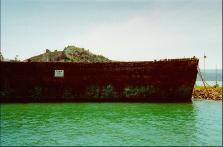 (142 Kb jpeg)
(142 Kb jpeg)
It is never a pretty sight when a ship is left to die and it is especially tragic to me when a sailing ship is so left. To me the mystique and sense of history that sailing ships have make it impossible to consider that these ships could be just discarded and left to rot in some forgotten port a long ways from her home port. Of course no doubt the same sort of thing will be said of the various kinds of cars, planes and the like that we are using now. All the same something about it being a sailing ship tugs at my more sentimental side.
As you have no doubt guessed the Edwin Fox is such a ship. Having lived a varied and quite diverse life over the years she was abandoned near Picton and left to rot. Given that she was made out of solid teak this seems a criminal waste of wood but offers us the chance to see first hand how well the ship builders of yesterday knew their craft. Thanks to how and where she was beached a significant section of the lower hull was covered by mud and protected from the elements remarkably well. Sufficiently so that when the time came to move the ship, from what had been her resting place for so long, the hull still floated.
This is about the only bit of luck the ship has had though, as the two next photographs show.
These both were shot from wharf carparking just opposite where the Edwin Fox is berthed for a very extensive refurbishment and repair session. As you can see only the basic hull is left, the masts long since gone along with the railing, top decks and the other miscellany that make up a ship. From the outside things look distinctly shabby as her copper sheathing is very tarnished and the exposed wood, unsurprisingly, weather beaten.
Visible in the background is the museum dedicated to the ship and through which you must pass to be afforded access to ship itself. It is well worth your while spending some time reading the exhibits in the museum not only because you have paid to see them and the ship but because they prime you for the experience of walking on the ship so that you can recognise what you are looking at and fill in what is missing.
Stepping onto the lower deck offers a glimpse of the grandeur the ship must have had when she was new. Especially when you realise that the deck you are standing on was the steerage class and thus the most confined and cramped level. Stubs of the masts poke up and a bit of the roof of this deck remains. When you consider that about sixty people lived on this deck for the months long voyage out to New Zealand you get a feeling of both size and confinement.
The hole in the hull visible on the left side of the photograph, about level with the mast, was a late addition to the ship. It dates from her days as a sheep transport and coalier when bulk goods needed to be loaded on and off the ship. You can also see a hatchway in the deck, just in front of the mast, which afforded crane and winch access to the cargo hold. But this isn't where the true treasure of the ship lies. Going down the stairs into the ballast and cargo hold is where you get the best impression of what the ship was like new.
Here you can see the well presevered teak of the inner hull, the keel and the mast mounting points. Combine that with a somewhat more substantial deck above your heads and the sense of actually being on a ship is very strong. Adding to it is the very slight motion as the hull vibrates with the waves, the sound of water lapping against the hull and, most importantly, the glorious smell of slightly damp wood. It is a smell I hope I remember for a while because it is the most unique part of visiting the Edwin Fox. The other ships I have visited have either been replicas (like the Endeavour) with fresh wood in that hasn't had time to settle in its' smell or ships where other smells dominated (the Earnslaw with it's steam engines smells of coal and oil).
Adding to the experience was the bright sunlight creating areas of strong shadow. With a little imagination it was easy to recreate scenes from many a swashbuckler tale where the hero of the story has been shut into the cargo hold and only small rays of light penetrate down to illuminate. Just stand in the shade for a moment and shut your eyes...
Because the Edwin Fox is so handy to the Inter Island Ferry it is something that is easy to work into any travel plans you have for touring around New Zealand. And I think it is worth the hour to two hours it takes to go through the museum, and then drink your fill of the ambience of being on whats left of the Edwin Fox. However you must be prepared to exercise your imagination somewhat because there very little of the ship left to see other than the basic hull. However combining the sounds, smell and feel of the ship with the photographs, paintings and descriptions of the ship from the museum allows you to get a good feel for what the eventual aim of the restoration project is.
Gross Tonnage :- 747 tons.
Registered Tonnage :- 836 tons.
Waterline Length :- 144 feet 8 inches.
Total Length :- 160 feet.
Waterline Breadth :- 29 feet 8 inches.
Depth :- 23 feet 6 inches.
Builder :- William, Henry & Foster, Calcutta.